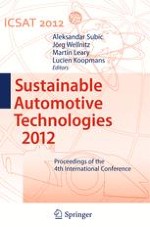2012 | OriginalPaper | Buchkapitel
On the Application of Compressed Natural Gas for an SI Internal Combustion Engine and Two Different Injector Positions
verfasst von : Christopher Soanes, Lucien Koopmans
Erschienen in: Sustainable Automotive Technologies 2012
Verlag: Springer Berlin Heidelberg
Aktivieren Sie unsere intelligente Suche, um passende Fachinhalte oder Patente zu finden.
Wählen Sie Textabschnitte aus um mit Künstlicher Intelligenz passenden Patente zu finden. powered by
Markieren Sie Textabschnitte, um KI-gestützt weitere passende Inhalte zu finden. powered by
The application of compressed natural gas (CNG) as automotive fuel has several advantages over gasoline. Natural gas is more economical, has better knock resistance, a wider range of flammable air fuel ratio, as well as lower carbon monoxide, carbon dioxide and hydrocarbon emissions. It is proving to be a worthy alternative to traditional fossil based fuels. Mixture homogeneity in an internal combustion (IC) engine has a significant effect on performance parameters such as power, torque, fuel consumption, emissions, combustion rate and exhaust temperatures. However, homogenous mixture formation with a gaseous fuel is much harder to achieve than with liquid phase fuel due to the limited shear stress between the CNG jet and air. An experimental study using a 3.8L V6 engine (typical of the popular large Australian sedans) and variations in injector location and injection timing were investigated to gain further understanding of its effects on combustion characteristics, performance and emissions. Beside the standard gasoline fuel delivery system, two different CNG systems with different injector positions were used, targeted and non-targeted. For the targeted injector position, the injectors replaced the gasoline injectors and were placed in the same position and angle pointing towards the intake valves. For the non-targeted position, injection nozzles were equally distributed on an adapter ring which was mounted directly downstream the throttle body. The obtained results showed unexpectedly similar engine stability performance for both CNG systems. Discussions examine different avenues that are likely to explain why there is similar mixing performance for both systems. Also, compared to gasoline operation, lower emissions and higher lean limit were accomplished for the engine operating on CNG.
